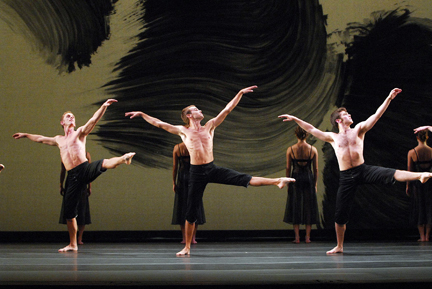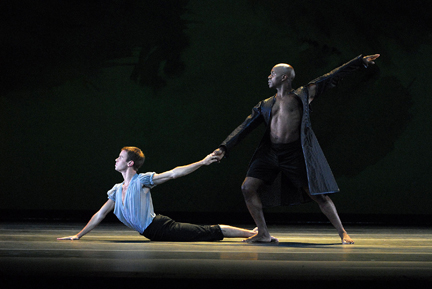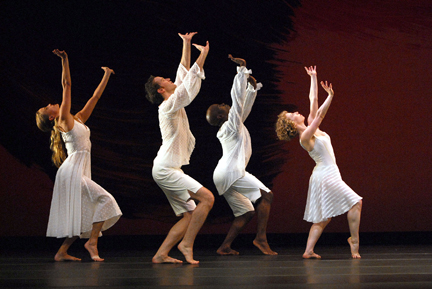Mark Morris's New, Glorious "Mozart Dances"
“Mozart Dances”
Mark Morris Dance Group
Presented by Mostly Mozart Festival
New York State Theater
New York, NY
August 17, 2006
by Susan Reiter
copyright ©2006 by Susan Reiter
 What an abundant, infinite world of emotional possibility Mark Morris has fashioned in his expansive new evening of three separate but inter-related works set to Mozart. One can sense him choreographing with a strict sense of discipline, marshalling all the considerable craftsmanship at his disposal, yet at the same time he opens a window on our humanity. “Mozart Dances” provides moments of poignancy — meditations on the pain of solitude or rejection, allusions to a mentor being abandoned, or possibly surpassed, by his protégé — as well as warm celebrations of the joys of companionship, the strength of communal support, the give-and-take within a layered society.
What an abundant, infinite world of emotional possibility Mark Morris has fashioned in his expansive new evening of three separate but inter-related works set to Mozart. One can sense him choreographing with a strict sense of discipline, marshalling all the considerable craftsmanship at his disposal, yet at the same time he opens a window on our humanity. “Mozart Dances” provides moments of poignancy — meditations on the pain of solitude or rejection, allusions to a mentor being abandoned, or possibly surpassed, by his protégé — as well as warm celebrations of the joys of companionship, the strength of communal support, the give-and-take within a layered society.
The three dances certainly could (and possibly will) stand on heir own, but together they provide a trajectory that leads a viewer to a sensation of fullness and generous completeness by the end of the evening’s just-over-two hours’ duration. They are united by their music — two piano concertos, (No. 11, K. 413, and No. 27, K. 595) framing the Sonata in D Major for Two Pianos, K. 448 — and their endlessly inventive, wondrously spare, investigation of those scores. On this first viewing, Morris’ relaxed, unforced approach, and his ability to incorporate breathing space into the choreography seems to allow extra clarity and refinement to emerge from Mozart’s music.
The movement favors the soft and supple more than the robust and earthy. Phrases seem to well up with spontaneity and wind themselves around and into each other. Motifs establish themselves and recur gently, without insistence, but enough to establish a connective thread throughout the evening. The design elements play a part in shaping a cohesive evening. Martin Pakledinaz’s simple, softly shaped costumes are black in the first piece, grey-and-black in the second, a gleaming ivory in the third. Howard Hodgkin’s scenic design, which I found more jarring than supportive to the overall effect, offers three varied panels of what look like giant paint brush smudges on a white expanse, which James F. Ingalls’ lighting subtly bathes in varied tones from time to time.
Each dance has a cast of sixteen (though not the exact same sixteen) listed alphabetically, but in the first two works, Morris has created major soloist roles that very much set the tone. The intrigue and potential for drama of solo figure set against, or within, a group then gives way to the vigorous warmth and expansiveness of the
In the opening work, “Eleven,” after the full cast is revealed in a silhouetted line across the stage and the men launch the action in brief, buoyant unison, the women take over and the men are never seen again. Lauren Grant, dressed in a chic black slip-dress, is the counterpart of the piano, establishing the lovely suspended movement quality that seems to rise and fall with the naturalness of breathing as she spools through turns with her arms softly open. The other seven women, wearing a filmy black layer over bras and briefs, come and go as the orchestra’s counterpart, often rushing in and out almost breathlessly, sometimes with the sporty look of joggers. A motif that is to recur throughout the evenings — hands placed at the side of the head, elbows jutting out — crops up amid both Grant’s and the ensemble’s movement. Everyone seems to coexist easily, but then suddenly, during the cadenza, Grant falls on her side and suddenly the other women become watchful, and a new note of concern, dependence and need is interjected. They leave her, and she then makes her exit on the very last note of the music.
The second movement opens with an emphasis on stillness, as Julie Worden is positioned far from the rest of the ensemble, who pause and look upwards. Morris makes us sense the distances between people, the implications of open spaces, keying elegantly off the music’s serenity. Grant waves through sparingly, at one point leading the others along a diagonal journey, later passing through as they stand with arms upraised, each letting her arms fall as she draws near.
 Morris brings back, and multiplies the falling onto one’s side image in the third movement, although he inserts it in a matter-of-fact it never creates any falsely dramatic imagery. Trios and duets emerge and sometimes overlap, but the striking final image, as the music reaches its gentle fadeout, is of one of the ensemble women on the floor, body torqued, reaching out for help that does not come.
Morris brings back, and multiplies the falling onto one’s side image in the third movement, although he inserts it in a matter-of-fact it never creates any falsely dramatic imagery. Trios and duets emerge and sometimes overlap, but the striking final image, as the music reaches its gentle fadeout, is of one of the ensemble women on the floor, body torqued, reaching out for help that does not come.
In “Double,” the men get equal time, and the women are absent except for an intriguing, nurturing appearance during the exquisite second movement. Joe Bowie, whose dancing is growing richer with new MMDG season, has the spotlight here, as a figure of gravitas, and a touch of wit, who sports an open black coat and knee-length pants that subtly evoke an 18th-century look. His movement has a sharper edge, and amore emphatic connection to the music, than Grant’s did, playing up accents. The other men, appearing alongside him or between his appearances, sport filmy grey sleeveless tops and black leggings that suggest britches. They move with an intriguing blend of softness and swagger; some of their arm gestures are so gentle and fluid that they evoke images of sylphs, but they can also dash across with bold energy. Throughout the movement, one senses how effortlessly Morris is using basic building blocks of movement to build a lofty structure, feeding off the music sequence of separate and overlapping themes, and their recapitulations, with blithe sophistication.
Then comes the truly extraordinary central movement of the sonata (and, by extension, of the full evening), in which a linked circle of six men revolves, opens into patterns that wind around and through, then reshapes itself. It is all placed so subtly on the music that we seem to be drawn deeply within a private, intimate society. There were moments here that have the same melancholy beauty that Balanchine drew out of the slow movement of Mozart’s “Symphonie Concertante,” where six women form a protective, soothing bubble around each soloist.
Noah Vinson, a figure of delicacy and vulnerability here, intrudes on, and to some extent, joins this brotherhood, borne aloft so that he seems to float. Bowie injects a more juicy, assertive tone, and suddenly the eight women, in long filmy skirts, appear to augment the circling imagery. Suddenly there are two circles, with Vinson at the center, and Bowie outside the perimeter, excluded. There are subtle possibilities here — perhaps a master and his apprentice, or a mentor whose protégé is ready to take on the world. It may be a coincidence that this scenario suggests itself when Morris is choreographing to a sonata that Mozart wrote for a gifted student to perform alongside himself, as an equal.
The men have the third movement to themselves; it is launched on a jaunty note by David Leventhal and Bradon McDonald, who accentuate the slightly facetious swaggering established in the first movement. Pairs of guys rush on and off; as the flow of movement is energetic but never hectic. Along the way, Morris deftly draws our attention to the music’s rhythms, riding them graciously and playfully. As the music reaches an emphatic conclusion, the men all stand rooted in place, slap their thighs, leaving a final, robust image.
 For “Twenty-Seven,” the concluding work. it’s very much boys and girls together, as everyone wears varied, somewhat folksy ivory costumes, with particularly flattering and individual dresses for the women. Here we are in territory that feels akin to some of Morris’ other works, but with an extra air of refinement and buoyancy. Movement motifs seem earlier bob up to the surface, and dancers who led the action earlier have their moments but so does nearly everyone else. The overall effect is of pristine, elegantly shaped patterns and encounters, bristling with an extra edge of clarity and invigorating byplay with the score. Morris effortlessly divides the ensemble into two halves, then presents a series of quartets. It has all the uplifting, celebratory beauty and warmth of “L’allegro, Il Penseroso ed Il Moderato” but also a sense of communal power achieved after sorrows and tribulations. As the concerto concludes, the men are suddenly grouped on one side, the women on the other, forming separate, perhaps confrontational wedges. It’s an intriguing, surprising final image, an allusion to the intensely segregated roles of what had come before, to the undeniable divide that exists.
For “Twenty-Seven,” the concluding work. it’s very much boys and girls together, as everyone wears varied, somewhat folksy ivory costumes, with particularly flattering and individual dresses for the women. Here we are in territory that feels akin to some of Morris’ other works, but with an extra air of refinement and buoyancy. Movement motifs seem earlier bob up to the surface, and dancers who led the action earlier have their moments but so does nearly everyone else. The overall effect is of pristine, elegantly shaped patterns and encounters, bristling with an extra edge of clarity and invigorating byplay with the score. Morris effortlessly divides the ensemble into two halves, then presents a series of quartets. It has all the uplifting, celebratory beauty and warmth of “L’allegro, Il Penseroso ed Il Moderato” but also a sense of communal power achieved after sorrows and tribulations. As the concerto concludes, the men are suddenly grouped on one side, the women on the other, forming separate, perhaps confrontational wedges. It’s an intriguing, surprising final image, an allusion to the intensely segregated roles of what had come before, to the undeniable divide that exists.
True to its presentation by Lincoln Center’s venerable Mostly Mozart Festival (which has featured Morris’ company regularly since 2002, but never commissioned a new work before), “Mozart Dances” had deluxe musical forces in the pit. Louis Langree, the Festival’s music director, conducted the Mostly Mozart Festival Orchestra. Emanuel Ax was the soloist in both concertos, and performed the sonata with Yoko Nozaki. Aside from a brief moment of uneasiness in the sonata, the music received excellent, lucid, rhythmically vibrant performances.
The program will also be seen in Vienna and London, since its co-commissioning organizations, along with Lincoln Center, are New Crowned Hope (a Vienna festival directed by Peter Sellars) and the Barbican Centre. A work this bountiful and masterful deserves — requires — additional
viewings, and one can only hope there will be a way for it to return for future local performances.
Photos of "Mozart Dances" by Stephanie Berger.
Volume 4, No. 31
August 21, 2006
copyright ©2006 Susan Reiter
www.danceviewtimes.com